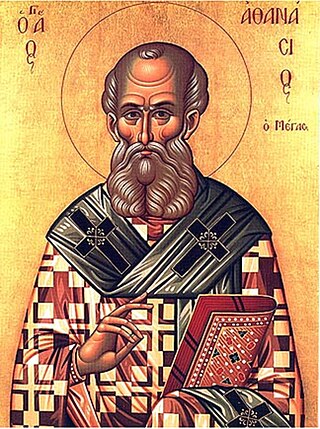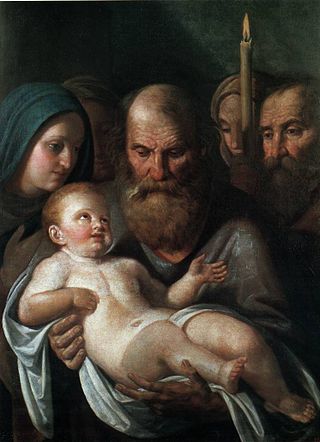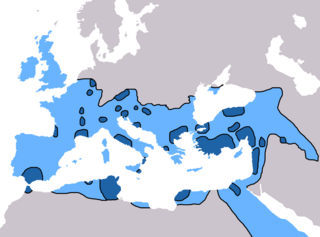
Athanasius I of Alexandria, also called Athanasius the Great, Athanasius the Confessor, or, among Coptic Christians, Athanasius the Apostolic, was a Christian theologian and the 20th pope of Alexandria. His intermittent episcopacy spanned 45 years, of which over 17 encompassed five exiles, when he was replaced on the order of four different Roman emperors. Athanasius was a Church Father, the chief proponent of Trinitarianism against Arianism, and a noted Egyptian Christian leader of the fourth century.
Pope Agapetus I was the bishop of Rome from 13 May 535 to his death. His father, Gordianus, was a priest in Rome and he may have been related to two popes, Felix III and Gregory I.
The 360s decade ran from January 1, 360, to December 31, 369.

Pope Liberius was the bishop of Rome from 17 May 352 until his death. According to the Catalogus Liberianus, he was consecrated on 22 May as the successor to Julius I. He is not mentioned as a saint in the Roman Martyrology. That makes him the earliest pontiff not to be venerated as a saint in the Catholic Church and, along with Anastasius II, one of only two popes to be omitted from Catholic sainthood in the first 500 years of church history.

Tikhon of Moscow, born Vasily Ivanovich Bellavin, was a bishop of the Russian Orthodox Church (ROC). On 5 November 1917 (OS) he was selected the 11th Patriarch of Moscow and All Russia, after a period of about 200 years of the Synodal rule in the ROC. He was canonised as a confessor by the ROC in 1989.
Eudoxius of Antioch was the eighth bishop of Constantinople from 27 January 360 to 370, previously bishop of Germanicia and of Antioch. Eudoxius was one of the most influential Arians.
The Patriarch of Antioch is a traditional title held by the bishop of Antioch. As the traditional "overseer" of the first gentile Christian community, the position has been of prime importance in Pauline Christianity from its earliest period. This diocese is one of the few for which the names of its bishops from the apostolic beginnings have been preserved. Today five churches use the title of patriarch of Antioch: one Eastern Orthodox ; one Oriental Orthodox ; and three Eastern Catholic.
An apostolic see is an episcopal see whose foundation is attributed to one or more of the apostles of Jesus or to one of their close associates. In Catholicism, the phrase "The Apostolic See" when capitalized refers specifically to the See of Rome.
Peter of Sebaste was a bishop, taking his usual name from the city of his bishopric, Sebaste in Lesser Armenia. He was the younger brother of Basil of Caesarea, Gregory of Nyssa, the famous Christian jurist Naucratius, and Macrina the Younger. He is also known as Peter of Sebasteia. Peter was not intellectually inferior to the more celebrated members of his family, but his genius "seems to have been rather practical than literary".

Eusebius of Vercelli was a bishop from Sardinia and is counted a saint. Along with Athanasius, he affirmed the divinity of Jesus against Arianism.

Lucian of Antioch, known as Lucian the Martyr, was a Christian presbyter, theologian and martyr. He was noted for both his scholarship and ascetic piety.

April 12 - Eastern Orthodox liturgical calendar - April 14

Simeon at the Temple is the "just and devout" man of Jerusalem who, according to Luke 2:25–35, met Mary, Joseph, and Jesus as they entered the Temple to fulfill the requirements of the Law of Moses on the 40th day from Jesus' birth, i.e. the presentation of Jesus at the Temple.

January 12 - Eastern Orthodox liturgical calendar - January 14
Saint Eusebius of Samosata was a Christian martyr and opponent of Arianism.

Al-Rastan is the third largest city in the Homs Governorate, located 25 kilometers (16 mi) north of its administrative capital Homs and 22 kilometers (14 mi) from Hama. Nearby localities include Talbiseh and al-Ghantu to the south, al-Zaafaraniyah and al-Mashrafah to the southeast, Murayj al-Durr to the northeast, Tumin to the north, Deir al-Fardis to the northwest and Kafr Nan and the Houla village cluster to the west. Ar-Rastan had a population of nearly 40,000 in 2004.
Eusebius of Rome, the founder of the church on the Esquiline Hill in Rome that bears his name, is listed in the Roman Martyrology as one of the saints venerated on 14 August.

Christianity in the 4th century was dominated in its early stage by Constantine the Great and the First Council of Nicaea of 325, which was the beginning of the period of the First seven Ecumenical Councils (325–787), and in its late stage by the Edict of Thessalonica of 380, which made Nicene Christianity the state church of the Roman Empire.

December 5 - Eastern Orthodox liturgical calendar - December 7
Saint Julian Sabas was a hermit who spent most of his life in deserted parts of Syria, but left his cell for a short period to denounce Arianism. His feast day is 14 January or 18 October in the Roman Church.








